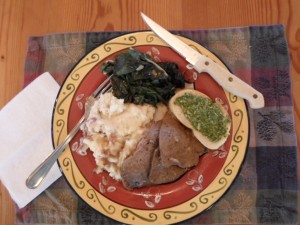Choosing the right cut of meat is very important when making a roast. I usually make pot roasts for several reasons. The cut of meat is cheaper, more readily found at the grocery store and I like the simplicity of one-pot meals. However I’ve been craving good roast beef. Prime rib is heavenly but expensive and I didn’t even see one at the store. I was looking for a round that could be cooked using dry heat and only saw very thin cuts. Not what I wanted in a roast. I ended up buying a 3-lb. chuck tender roast.
Chuck tender sounds like an oxymoron to me – you know like jumbo shrimp. I was hoping that maybe on the chuck-toughness scale, this one would be at the more-tender end. I decided to braise the roast which uses both dry heat and moist heat to cook.
I took the roast out of the fridge and let it sit while I quartered two onions and slivered garlic cloves. Using a thin knife, I cut slots in the roast and pushed in the garlic slivers. I liberally seasoned the roast with salt and pepper.
Finding a large oven-safe pot, I heated a couple of tablespoons of olive oil on the stovetop and seared the onion quarters at a high heat. Removing the onions, I then seared all the sides of the roast. Getting a nice caramelized surface on the meat is important to both the look and flavor of the finished roast.
When all sides have been seared, I removed the roast and added 3⁄4 cups of a good red wine to deglaze the pot. I added the onion quarters back to the pot and place the roast on top and I included three bay leaves. I covered the pot with a tight lid and placed it in a 300-degree oven for about an hour.
Earlier I had made French bread dough in my bread machine to save my having to do all the kneading. So, I shaped it into two loaves and let them rise while the roast cooked. I also made basil pesto to serve with the bread or to garnish the roast. Then I prepared the smashed potatoes I’d be serving with the roast and cleaned Swiss chard for a side.
After an hour the roast’s internal temperature was at 135 degrees. I put it back in the oven for another 15-20 minutes until it came to 155 degrees. I let the roast rest for a full 30 minutes to make it easier to slice very thin. I baked the French bread and wilted the chard in olive oil with onions, garlic and red pepper flakes.
The roast was very tasty. It was not as tender as a better cut of meat would have been, but it wasn’t like eating shoe leather either. Slicing it very thin against the grain and serving it with its own pan sauce made for a rather tender chuck roast.

